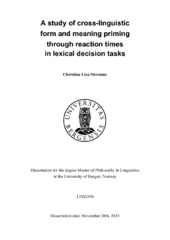| dc.description.abstract | In a series of open priming lexical decision tasks, the influences of meaning form and lexical reaction time were investigated. All experiments used the same stimuli in order to be able to compare the collected reaction time data across all experiments. The form and meaning influences on cross-linguistic English and Norwegian stimuli were tested across four categories: cognates (+ meaning, + form), translations (+ meaning, - form), lookalikes (- meaning, + form) and unrelated (- meaning, - form). Experiment 1 was a one-directional lexical decision task, where all primes were English words and their respective targets were Norwegian or non-words (L2-L1). Experiment 2 investigated the same stimuli in the opposite language direction, such that all primes were Norwegian and their respective targets were English or non-words (L1-L2). Experiments 3 was a direct replica of experiment 2, although recruiting a different set of participants where the participants were beginner-learner Norwegian speakers with a first language that differs from English (L3-L2). Experiment 4 was a mixed language experiment, where half of the targets in each category was English primed by Norwegian and the other half were Norwegian primed by English (L1-L2 and L2-L1). The four experiments show a main effect form meaning (~47ms), however form effects did not reach significant levels in experiments 1-4. A separate (unprimed) baseline study was conducted to account for any potential problems with the stimuli. This made it possible to correct the first four experiments against the lexical reaction times collected in the baseline study. A correction for lexical reaction times indicated that the highly significant main effect for meaning in the first four experiments, although smaller, continued to facilitate response times (~25ms). The form effects were non-significant after correction. However, a between subject baseline may not be ideal, as the differences in proficiency and subjective frequencies cannot be accounted for sufficiently. Experiments 5-8 are slight variations of the mixed language experiment (4), with a counterbalanced within subject baseline. These experiments were analyzed together in order to account for priming effect for each word pair in both language direction (English-Norwegian and Norwegian-English). The counterbalanced baseline accounted for the lexical reaction times, such that when the mean lexical reaction time was accounted for, the priming effects are clearer. A significant main effect for meaning was found (-32.4ms). In line with the observations from experiments 1-4, form effects were non-significant. The accumulated results from all experiments suggest that, at least when the prime is visible for 100ms, the meaning bearing units for the prime words are activated aiding the process of word recognition in any of the language directions across these series of experiments. The form similarities did not reach significance, indicating that the across- language form similarities are non-significant aids when the meaning is activated. | en_US |
